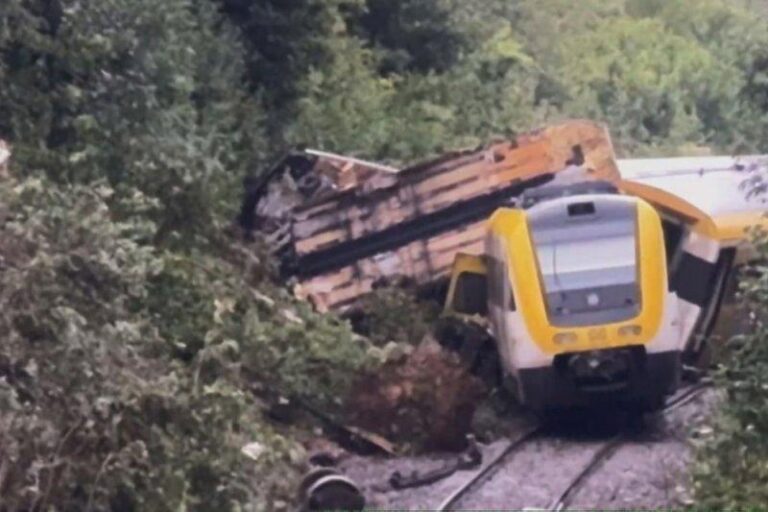A devastating train derailment in Germany that resulted in the deaths of three people appears to have been triggered by a landslide, authorities report. The incident, which has raised urgent safety concerns, occurred when the railway tracks were obstructed by debris following heavy rainfall. Rescue teams rushed to the scene as investigations began to determine the precise cause of the accident, highlighting the growing risks posed by extreme weather events to critical infrastructure.
Train Derailment in Germany Linked to Landslide Raising Questions on Terrain Safety
Officials have confirmed that a landslide was a key factor in the tragic derailment of a passenger train in Germany, which resulted in the deaths of three individuals. Preliminary investigations indicate that heavy rainfall in the region caused unstable terrain conditions, leading to the earth giving way just moments before the train passed through the affected area. This incident has sparked immediate concern among transportation authorities and geologists regarding the adequacy of current safety measures in regions prone to natural hazards.
In light of these events, experts are calling for a comprehensive review of slope stability monitoring systems alongside rail infrastructure maintenance. Key points under consideration include:
- Enhanced early-warning technologies to detect ground movement
- Regular geological surveying of vulnerable rail corridors
- Increased investment in preventive engineering works such as retaining walls and drainage improvements
- Cross-agency collaboration between transportation and environmental authorities
| Factor | Impact Level | Recommended Action |
|---|---|---|
| Soil Saturation | High | Installation of moisture sensors |
| Terrain Instability | Critical | Reinforcement of slopes |
| Weather Patterns | Moderate | Continuous monitoring |
| Rail Infrastructure | Medium | Frequent inspections |
Investigating Infrastructure Vulnerabilities in Flood-Prone Regions
The recent train derailment tied to a landslide has cast a harsh spotlight on the fragility of essential infrastructure in regions susceptible to excessive rainfall and flooding. Critical transport routes, particularly those traversing hillsides or riverbanks, are increasingly at risk due to shifting soil compositions and inadequate drainage systems. Experts now emphasize the urgent need for comprehensive geotechnical surveys to identify vulnerable spots before disaster strikes, especially as climate change intensifies storm patterns and increases groundwater saturation.
Key vulnerabilities identified in flood-prone infrastructure include:
- Unstable embankments prone to erosion or sudden collapse
- Insufficient water management causing soil saturation and landslides
- Aging railway ties and tracks lacking reinforcement against ground movement
- Limited real-time monitoring of soil shifts and water levels
| Risk Factor | Impact | Mitigation Strategy |
|---|---|---|
| Soil Erosion | Track destabilization | Reinforced retaining walls |
| Floodwater Accumulation | Track flooding and washouts | Improved drainage systems |
| Landslide Susceptibility | Sudden track blockage | Early warning sensors |
Experts Call for Enhanced Monitoring and Preventative Measures to Avoid Future Disasters
Environmental experts and transport safety authorities are urging immediate implementation of advanced monitoring systems along vulnerable rail lines, particularly those passing through geologically sensitive regions. The recent tragedy has highlighted glaring gaps in current safety protocols, notably the lack of real-time surveillance to detect potential landslides or ground shifts. Experts recommend deploying a combination of early-warning sensors, drone inspections, and satellite imaging to better anticipate natural threats that could compromise rail infrastructure.
In addition to technological upgrades, specialists advocate for comprehensive preventative strategies that include:
- Regular geotechnical assessments along high-risk tracks
- Enhanced training for railway operators on emergency response
- Investment in reinforced retaining walls and drainage improvements
- Community engagement programs to report visible hazards promptly
| Proposed Measure | Potential Impact | Implementation Timeframe |
|---|---|---|
| Landslide Detection Sensors | Early hazard alerts, preventing derailments | 6-12 months |
| Drone Surveillance | Real-time visual inspections of track conditions | 3-6 months |
| Geotechnical Surveys | Identification of weak ground zones | Ongoing, biannual |
Key Takeaways
As authorities continue their investigation into the tragic derailment, attention remains focused on assessing the full extent of damage and ensuring the safety of the rail network. Officials have pledged to implement additional monitoring measures in the region to prevent similar incidents in the future. The incident serves as a stark reminder of the potential impact of natural hazards on critical infrastructure and the ongoing need for vigilance in disaster preparedness.




